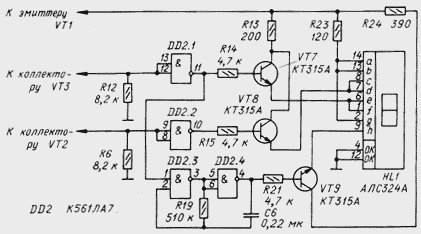In "Radio", 1997, No. 6, pp. 42, 43, was published the article of A. Ledengin "The mode indicator battery". Some time after I gathered this indicator and began to exploit it in his car, revealed one disadvantage.
The fact that my car was already mounted led indicator health lamps, direction indicators and brake light. The use of LEDs red and green fluorescence in both devices often led to the erroneous the perception of information, and pulsed glow only aggravated the situation.
For everyone who has faced a similar problem, I suggest to modify the indicator A. Ledengin by replacing two LEDs HL4, HL5 (according to the scheme in its article) semielemental digital indicator. When charging the battery batteries highlights the symbol "a" and battery "P" with a flashing decimal point. This display more clearly displays the mode of operation of electrical equipment as car and motorcycle.
Diagram of the node that you want to modify in the figure; enumeration the elements on it matches the source. Elements R20, R22, C7 excluded, but additionally introduced R23, R24.

The principle of operation remains the same. When you receive high-level output item DD2.1, which corresponds to the mode of discharge of the battery, open transistor VT7 and includes elements e and f of the indicator HG1. Together with constantly luminous elements a, b and g forms an image of the "P"symbol.
At the same time allowed the operation of the generator subsonic frequencies on the elements DD2.3, DD2.4. Decimal point h switching transistor VT9, begins occasionally switch, attracting the attention of the driver.
In charging mode, the high level at the output of the element DD2.2 opens the transistor VT8 and thus includes elements c, d of the indicator - the display will show "e". A low level at the output of the element DD2.1 prohibits the operation of the generator. Transistor VT9 remains closed, therefore, the point h on the indicator off.
The establishment of a modified indicator is reduced to equalize the brightness of elements of the indicator HG1 selection of resistor R23.
Author: M. Romashchenko, Voronezh






